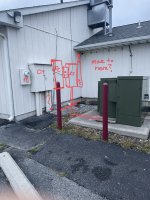Ryancbell121
Member
- Location
- Pennsylvania
- Occupation
- Master Electrician
The wall where the 2 new services are going is almost too small. This means to save room I will have to Knockout a 4 inch hole in the top of the outdoor service disconnect for the feeders to the electric room inside. I was thinking of just using 4" pvc from the dc so its easier to back to back LB the wall. So my question is, what is the best method for using the top of outdoor equipment with conduit? Myers hub to pvc connector to pvc? Or, Myers hub to emt connector to emt? Or other?


